Abstract
There are a large number of fahlores recognized in the Zijinshan ore field, including tetrahedrite, tennantite, Zn-rich tetrahedrite, goldfieldite, Bi-rich tetrahedrite, etc. The changes in their mineral composition have significance for the evolution of the ore-forming environment. This article presents a detailed study of the fahlores using electron probe analysis. The results indicate that in the Zijinshan Au-Cu deposit, fahlores are Te-rich in shallow zones and Zn-rich in deep zones. The Zijinshan Xi’nan deposit is generally Zn-rich, with a Bi-rich in middle levels. The Longjiangting deposit is Sb- and Zn-rich in shallow zones and As- and Bi-rich in deep zones, whereas the Yueyang deposit is Sb- and Zn-rich in shallow zones and Bi-rich in deep zones. The fahlores in the Zijinshan ore field often show zoning in backscattered images due to As and Sb variations. From the porphyry to high-sulfidation stages, fahlores evolve from Fe-rich to Zn-, Bi-, and Sb-rich, and finally to Te-rich. From the porphyry to low-sulfidation stages, fahlores transition from Bi-rich to Zn-rich and eventually to Ag-rich compositions. The discovered mineral assemblages of the fahlores are of great significance for understanding the framework of complex porphyry shallow hydrothermal environments and prospecting for underlying porphyry ore bodies in the Zijinshan ore field.
1. Introduction
Porphyry deposits, as significant sources of metals, such as Cu, Au, and Mo, provide more than 70% of the world’s Cu resources, over 50% of Mo resources, more than 20% of Au resources, the majority of rhenium, and small amounts of Ag, Pb, Te, Se, Bi, Zn, and other elements [1,2]. The Zijinshan ore field in Shanghang County, Fujian Province, is situated within the continental marginal activation zone of the Circum-Pacific metallogenic belt. It lies on the western side of the Mesozoic volcanic activity belt along the southeastern coast of China, at the intersection of the northwest-trending Shanghang-Yunxiao deep fault and the northeast-trending Xuanhe anticlinorium [3]. The region boasts excellent metallogenic conditions, with multi-phase and multi-stage tectonic and magmatic activities, resulting in abundant mineral resources, primarily the metallogenic series of Cu, Au, Mo, and Ag deposits related to the late Yanshanian volcanic-intrusive activities. After decades of geological exploration, several deposits have been discovered within the ore field, including the Zijinshan high-sulfidation (HS) epithermal Au-Cu deposit, the Longjiangting and Wuziqilong transitional Cu deposits, the Luoboling porphyry Cu-Mo deposit, the Yueyang low-sulfidation (LS) epithermal Ag-polymetallic deposit, and some transitional Cuore sections (points). This ore field represents one of China’s super-large unified porphyry-epithermal metallogenic systems [4]. Recent research studies suggest that there is still prospecting potential for concealed porphyry deposits in the deep parts of the Zijinshan ore field [4,5].
Fahlores [(Cu,Ag)10(Cu,Fe,Zn,Hg)2(As,Bi,Sb,Te)4(S,Se)13] are widely distributed in hydrothermal deposits, although in minor quantities compared with other sulfides. They act as important indicator minerals in hydrothermal deposits, including base metal deposits, and volcanic massive sulfide (VMS) deposits, and in porphyry-epithermal systems. They carry significance for genetic interpretation where they display chemical variations, which are a response to evolving fluid chemistry from which they crystallized [6,7,8,9,10,11,12,13,14]. Research indicates that fahlores display varying compositional features in porphyry-epithermal systems, where the compositional evolution of fahlores shows systematic variations relative to the porphyry center, providing potential prospecting significance [9,15,16]. Marushchenko distinguished different evolutionary trends for fahlores of porphyry, transitional epithermal-porphyry, and intermediate-sulfidation epithermal settings [9]. In porphyry deposits, fahlores’ compositions evolve from tennantite-(Fe) to tetrahedrite-(Zn), whereas in transitional deposits, they evolve from tetrahedrite-(Zn) to tennantite-(Zn), and finally to goldfieldite.
Additionally, the Cu and Fe in fahlores are significant for determining the oxidation state of Fe [17,18]. Spectroscopic research on synthetic fahlores indicates that higher Cu correlates with higher Fe3⁺ [19]. By examining the ratio of As to Sb in fahlores, characteristics such as fluid oxygen fugacity and temperature can be inferred. The relative proportions of tetrahedrite molecules are related to the mineralization temperature. By treating fahlores as a mixture of pure tetrahedrite and pure tennantite, and using EPMA to measure the percentage content of As and Sb in fahlores, the As/(Sb+As) ratio can be calculated to estimate the mineralization temperature [20].
Fahlores often exhibit various types of zoning in BSE images, with oscillatory zoning being one of the more distinctive types. Based on previous research [21], the formation of oscillatory zoning in fahlores in porphyry deposits is primarily attributed to the substitution between As and Sb; in other types of deposits, zoning may result from substitutions among trivalent elements (Te, As, Sb, Bi) or divalent elements (Hg, Fe, Zn). The different zoning patterns can also provide insights into the evolution of the hydrothermal fluids [8,21,22].
In the Zijinshan ore field, fahlores often occur as associated minerals, including Bi-rich tennantite, Zn-rich tennantite, Bi-rich tetrahedrite, and goldfieldite [23,24]. This article will discuss the Fahlores of the porphyry and transitional and epithermal stages in the Zijinshan ore field. These findings have been used to attempt to establish criteria to distinguish mineralization stages associated with variations in the composition of the ore field and to provide clues for further deep porphyry prospecting.
2. Regional Geology
The Zijinshan ore field is located in the southwestern part of Fujian Province, within the Circum-Pacific metallogenic belt on the South China Block, and lies on the western side of the Mesozoic volcanic belt along the Fujian coast. It lies at the intersection of the northwest-trending Shanghang-Yunxiao deep fault zone and the northeast-trending Xuanhe anticlinorium [25]. Specifically, it is located at the northeastern margin of the Early Cretaceous Shanghang volcanic basin, where the northwest-trending Shanghang-Yunxiao deep fault intersects with the northeast-trending Xuanhe anticlinorium (Figure 1) [26]. The Zijinshan ore field is a coexistence of multiple deposit types within a porphyry-epithermal metallogenic system [3] and is currently the largest epithermal ore field discovered in China [27]. The Zijinshan mining area primarily includes the Zijinshan HS Au-Cu deposit, the Yueyang LS Ag-polymetallic deposit, the Luoboling porphyry Cu-Mo deposit, and the Wuziqilong and Longjiangting transitional Cu deposits [4,26,28,29].
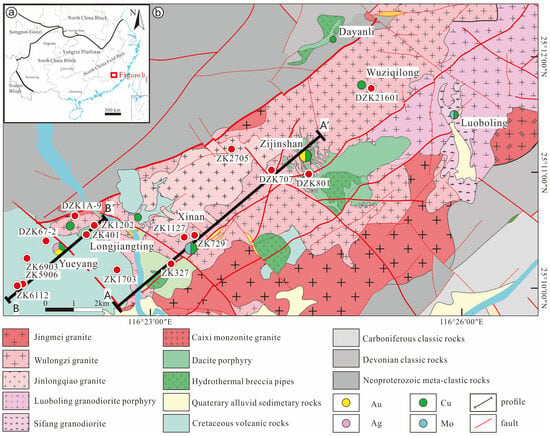
Figure 1.
(a) Tectonic map showing the location of the study area. (b) Regional geological map and drill hole location map of the Zijinshan ore field (modified from [5,26]).
The Zijinshan ore field is characterized by magmatic rocks that include the Middle-Late Jurassic Zijinshan granite complex and the Caixi monzogranite pluton [30]. The former is predominantly exposed in the central-southern part of the ore field and is the most common host rock for the Zijinshan Au-Cu deposit, while the latter is located in the central-northern part of the ore field. The Zijinshan granite complex consists of three intrusive phases, including the Jingmei pluton, the Wulongzi pluton, and the Jinlongqiao pluton, all of which are biotite monzogranites with textures ranging from coarse-grained to fine-grained outward [31]. To the northeast of the ore field, the Sifang granodiorite pluton is intruded by the Early Cretaceous Luoboling granodiorite porphyry, which is associated with Cu-Mo mineralization [32]. The volcanic rocks are primarily Early Cretaceous cryptoexplosive breccias, volcanic tuffs, and dacite porphyries, forming a dacitic volcanic dome in the central part of the Zijinshan ore field that is associated with Au-Cu mineralization [33]. The Zijinshan granite complex was first intruded by the Early Cretaceous Sifang granodiorite from the northeast and later by Late Cretaceous dacite dikes in the south. The volcanic center is filled with dacite porphyry, surrounded by cryptoexplosive breccias [34].
The Zijinshan ore field exposes a variety of stratigraphic units, including the Neoproterozoic Sinian basement rocks, Paleozoic Carboniferous and Devonian marine sedimentary cover sequences, Cretaceous volcanic rocks, and Cenozoic Quaternary deposits. The Sinian system is only exposed in the northwestern part of the study area, specifically the Lower Sinian Louziba Group. The Devonian Tianwadong Formation and Taozikeng Formation are exposed in the northwestern and southeastern parts of the study area. The Carboniferous Lindi Formation is primarily distributed in the southeastern part of the study area, while the Huanglong Formation and Chuanshan Formation are found throughout the study area. The Lower Cretaceous Shimashan Group of the Cretaceous system is mainly distributed in the southwestern part of the study area.
The Zijinshan area has undergone a long and complex geological evolution, with tectonic movements from different periods superimposed in the region, resulting in well-developed folds, faults, and volcanic structures. The main structures in the area are the northwest-trending Shanghang-Yunxiao fault and the Yueyang-Chishui, Longjiangting-Nanshan, and Jinshanjiao-Zhongliao faults. Among these, the northwest-trending structures controlled the late Yanshanian volcanic-intrusive magmatic activities in the region, providing conditions for ore hosting and control. Magmatic intrusions were controlled by the northeast-trending structures, and deposits and ore occurrences in the region are often found at the intersections of these structures and within northeast-trending volcanic edifices.
3. Deposit Geology
3.1. Zijinshan Au-Cu Deposit
The Zijinshan Au-Cu deposit is a typical HS epithermal deposit [34] and is located at the center of the Zijinshan ore field. The deposit includes the northwestern ore block, the southwestern ore block, and the southeastern ore block, with the core part being the northwestern ore block [23]. The main structural framework of the Zijinshan mining area is characterized by a grid-like pattern formed by the intersection of northwest-trending and northeast-trending fault zones. The mining area covers an area of 4.37 square kilometers [3].
The Au ore bodies of the Zijinshan Au-Cu deposit are primarily distributed in the oxidation zone above an elevation of 600 m, while the copper ore bodies are mainly found in the oxidation zone below 600 m, forming a distinct “Au above, Cu below” mineralization zoning pattern [35,36]. The fine-grained biotite granite, which is widely distributed in the area, serves as the main host rock for the ore. The Au and Cu ore bodies predominantly occur as hydrothermal breccias and veins, controlled by northwest-trending fracture zones, and generally exhibit irregular vein-like or lens-shaped distributions [34].
The Zijinshan Au-Cu deposit displays clear horizontal and vertical zoning of alteration minerals, with a silicified core transitioning outward to a banded advanced argillic zone of quartz-dickite and quartz-alunite, enveloped and underlain by sericitic alteration [36,37]. Dickite-alunite alteration is a typical characteristic of high-sulfidation type deposits. The advanced argillic alteration is also accompanied by minor amounts of diaspore, andalusite, and aluminum-phosphate-sulfate (APS) minerals (such as svanbergite and woodhouseite), which are considered to represent high-temperature conditions in the deeper parts of the lithocap [38]. Au mineralization is closely associated with silicification, while Cu mineralization is strongly linked to alunite alteration [5,23]. Au primarily occurs in Fe oxides and hydroxides, appearing as disseminated grains, veinlets/fracture fillings, and breccia cements [38]. Cu is mainly hosted in digenite, covellite, and enargite, with minor amounts of other copper sulfides, such as djurleite, chalcocite, bornite, chalcopyrite, and tetrahedrite [35]. Rare sulfosalt minerals and Sn-W-bearing copper sulfides have also been reported [25].
Research on the spatial alteration zoning [5], mineralization zoning [23], and fluid inclusion temperature mapping [39] of the Zijinshan deposit indicate a transition from epithermal mineralization to porphyry mineralization at depth. This is consistent with the porphyry mineralization characteristics revealed by deep drilling in the Zijinshan Au-Cu deposit [40].
3.2. Zijinshan Xi’nan Cu-Mo Deposit
The Zijinshan Xi’nan Cu-Mo deposit is located in the central-southern part of the Zijinshan ore field in Fujian Province, approximately 2 km southwest of the Zijinshan Au-Cu deposit. It is primarily situated along the axis of the Xuanhe anticlinorium. Preliminary exploration has identified a copper resource of about 20,000 tons (with an average grade of approximately 0.2%), accompanied by molybdenum mineralization [32]. The ore block exhibits an advanced argillic alteration zone in the shallow part, a sericitic alteration zone in the middle, and a propylitic alteration zone at depth. No potassic alteration zone has been identified so far [39].
The ore bodies in the southwestern ore block are primarily developed within granodiorite porphyry. Mineralization mainly occurs as disseminated and veinlet-disseminated chalcopyrite in ZK1127, ZK729, and ZK327, but these do not form a continuous ore body and are small in scale with low grades [41]. The ore minerals are mainly pyrite, chalcopyrite, molybdenite, and magnetite, with minor amounts of bornite, galena, sphalerite, and Zn-rich tennantite. The gangue minerals are predominantly muscovite, montmorillonite, illite, quartz, dickite, and kaolinite, followed by chlorite, epidote, anhydrite, gypsum, potassium feldspar, biotite, and calcite, with minor amounts of alunite and pyrophyllite. The ore textures are subhedral-anhedral, bladed, and tabular, while the ore structures are disseminated, veinlet-disseminated, and vein-like.
3.3. Longjiangting Cu Deposit
The Longjiangting Cu deposit is located in the southwestern part of the Zijinshan ore field, southeast of the Zijinshan Au-Cu deposit, and is connected to the large Yueyang Ag deposit to the south, all within the same geological structural unit. The early Yanshanian medium- to fine-grained granite is the most important ore-bearing host rock in the Longjiangting mining area [42]. The Cu ore bodies are primarily controlled by NW-trending faults and fractures, occurring as roughly parallel veins and lenses. The deposit features numerous ore bodies, each of small scale, distributed at elevations ranging from −40 to 300 m, mostly as concealed ore bodies, with the depth increasing from north to south.
The area exhibits extensive wall-rock alteration with strong hydrothermal activity and a variety of alteration types. The main alteration types include silicification, dickitization, sericitization, illitization, and pyritization. In the shallow parts, kaolinization and limonitization are predominant, with localized chloritization, carbonatization, adularization, and alunite alteration. Vertically, sericitization weakens from top to bottom, while dickitization gradually strengthens, transitioning into a dickitization-silicification alteration zone [43,44]. The Longjiangting Cu deposit contains a rich variety of metallic minerals, with copper sulfides being the most important, besides pyrite. Among these, chalcopyrite, bornite, and digenite are the most significant, followed by covellite, chalcocite, chalcanthite, and malachite. Chalcopyrite accounts for more than 50% of the total copper minerals [42].
3.4. Yueyang Ag-Polymetallic Deposit
The Yueyang Ag-polymetallic deposit is located on the southwestern side of the Zijinshan ore field, approximately 3 km southwest of the Zijinshan Au-Cu deposit. The intrusive rocks in the area are dominated by the early Yanshanian Zijinshan granite complex, which occurs in a “tongue-like” shape between the volcanic cover of the Shimashan Group and the shallow metamorphic rocks of the Louziba Group, serving as the primary host rock for mineralization [45].
The ore bodies in the Yueyang deposit can be divided into three segments. The lower segment, which forms the main body of the deposit, consists of multiple ore bodies with an overall NW trend, occurring as veins or lenses along fractures extending to the southwest or northeast. The middle segment is distributed within the Zijinshan granite complex, with ore bodies occurring as veins along fractures. The upper segment is controlled by the lithological interface between the granite and trachyandesite, also occurring as veins. The ore types in the Yueyang deposit are mainly breccia- and vein ores. The ore minerals are primarily chalcopyrite, sphalerite, galena, acanthite, native Ag, and pyrite. The gangue minerals are mainly quartz, chalcedony, illite, adularia, and calcite [45].
4. Samples and Analytical Methods
The samples for this study were collected from 12 drill holes in the Zijinshan ore field, including the Zijinshan Au–Cu deposit (ZK2705, ZK801, 12LC-2, Dig-A-2 and Dig-A, 13ZJ-11, 13ZJ-18, 13ZJ-22); Zijinshan Xi’nan Cu-Mo deposit (ZK327, ZK729, ZK1127); Longjiangting Cu deposit (ZK1202, ZK401, DZK1A-9, ZK301, ZK702); and Yueyang Ag-Polymetallic Deposit (ZK6112, ZK6511, ZK5906, ZK6903, DZK67-2, and ZK1703). These samples cover a wide range of mineralization types and geological settings within the Zijinshan ore field, providing a comprehensive basis for this study.
The measurements of major elements in the fahlores of the Zijinshan Au-Cu Deposit were completed at the Mineral Resources Laboratory, Fuzhou University. Firstly, secondary electron imaging (SEI) observation, backscatter imaging (BSE) observation, and energy dispersive spectroscopy (EDS) qualitative analyses were conducted on the samples observed by mineralogy using an electron probe. Based on this, a quantitative analysis of electron probe spectroscopy (WDS) and a local electron probe surface scanning analysis were performed on some samples.
Electron probe model: JEOL JXA-8230. The testing conditions for sulfide point analysis were an acceleration voltage of 20 kv, a beam current of 10 nA, a beam spot of 3–5 µm, an element peak integration time of 20 s, and a background integration time of 10 s. The conditions for surface scanning analysis were an acceleration voltage of 20 kv, a beam current of 50 nA, and a scanning point distance of 1 µm. The standard samples were natural sulfides and metals, including metals Au, Ag, W, Sn, and V. Sulfides included natural FeS2, CuFeS2, ZnS, and PbS, and artificially synthesized GaAs, GeS, CdSe, etc. The measured data were calibrated using the ZAF program. The minimum detection limit of elements was greater than 100 ppm.
5. Mineralogy of the Fahlores in the Zijinshan Ore Field
Through experimental research on the common occurrence of fahlores in different spatial locations in various deposits of the Zijinshan ore field, it was found that the types, mineral combinations, and chemical compositions of fahlores exhibit regular distribution characteristics with changes in the spatial location of the ore body.
In the Zijinshan Au-Cu deposit, the fahlores in the ore are primarily goldfieldite, distributed above −400 m, and coexist with HS copper minerals, such as covellite, digenite, and enargite. In the Zijinshan Xi’nan Cu-Mo deposit, the dominant fahlores are Zn-rich, associated with sphalerite, galena, chalcopyrite, and covellite-digenite. In the Longjiangting deposit, the fahlores, including Zn-rich tennantite and Bi-rich tetrahedrite, are distributed from −150 m to 225 m and coexist with enargite, bornite, sphalerite, and wittichenite. In the Yueyang deposit, the fahlores are mainly distributed at elevations of −100 to 20 m, deepening toward the northwest, and are enriched in Zn and Ag, associated with sphalerite, galena, and chalcopyrite. ZK1703, located at the intersection of the Yueyang deposit, Longjiangting deposit, and Zijinshan Xi’nan deposit, contains abundant fahlores from shallow to deep levels, with associated mineral characteristics similar to those of the Zijinshan Xi’nan deposit.
5.1. Zijinshan Au-Cu Deposit
In the Zijinshan Au-Cu deposit, the shallow part is characterized by a dickite-alunite alteration zone, while the deeper part exhibits a sericite alteration zone. Fahlores are present in both zones. In the dickite-alunite alteration zone, the fahlores are predominantly Bi- and Te-rich tennantite, with occasional occurrences of Te-rich tetrahedrite.
The copper mineral combination in the shallow open-pit alum mineralization zone of the Zijinshan Au-Cu deposit is characterized by Te-rich tennantite + Te-rich tetrahedrite + covellite. An EPMA analysis shows that tetrahedrite is mainly rich in Sb (up to 15.36 wt%) and Te (up to 18.81 wt%); the copper minerals in the middle level of the deposit are characterized by tin minerals, such as Te-rich tennantite + stannite + colusite ± covellite. The EPMA analysis shows that the composition of fahlores is relatively uniform, with Sb (0–1.49 wt%), Te (0–13.08 wt%), and Bi (0–8.73 wt%); the ore in the sericite alteration zone of the deep drilling of the Zijinshan Au-Cu deposit is characterized by a combination of Zn-rich tennantite + chalcopyrite ± Te-rich tennantite. The EPMA analysis shows that the mineral composition of the fahlores is rich in As (up to 20.27 wt%), Zn (up to 8.16 wt%), and Bi (up to 25.44 wt%). The fahlores in the Zijinshan Au-Cu deposit are generally rich in Te, with an increase in the enrichment of Sb and Te from deep to shallow, and a decrease in the enrichment of Zn and Bi. The mineral compositions of the fahlores from deep to shallow exhibit a change from rich in Zn, As, and Bi to rich in Te and Sb (Table 1).

Table 1.
EPMA analysis results of fahlores in the Zijinshan Au-Cu deposit (wt%) (some data quoted from [23]).
Fahlores are found throughout the Zijinshan Au-Cu deposit, from shallow to deep levels, and rarely exhibit zoning in BSE images. In the shallow part of the deposit, the fahlores are small in size and replace enargite and covellite (Figure 2a–c). They are light gray and typically less than 10 mm in size. In the intermediate part of the deposit, the fahlores are replaced by stannite and coexist with colusite, appearing light gray and measuring less than 30 mm (Figure 2d,e). In the deep part of the deposit, the fahlore grains are mostly larger than 50 mm and dark greenish-gray in color with the compositions of Zn-rich tennantite. Goldfieldite forms solid solutions with the Zn-rich tennantite. The Zn-rich tennantite are intimately associated with chalcopyrite, replacing pyrite and being replaced by wolframite (Figure 2e,f).

Figure 2.
Reflected light images of the fahlores and associated minerals in the Zijinshan Au-Cu deposit. (a) Te-rich tennantite replacing enargite in the upper part of the Zijinshan Au-Cu deposit (ZK2705-7, z = 723.41 m); (b) Te-rich tennantite replaced by covellite (ZK2705-9, z = 679.01 m); (c) Te-rich tennantite replacing enargite in the central part of the Zijinshan Au-Cu deposit (ZK2705-17, z = 257.51 m); (d) Te-rich tennantite replacing colusite in the deep part of the Zijinshan Au-Cu deposit (ZK2705-47, z = 57.03 m); (e) Zn-rich tennantite associated with wolframite in the deep part of the Zijinshan Au-Cu deposit (ZK2705-53, z = −21.75 m); (f) Zn-rich tennantite in the deep part of the Zijinshan Au-Cu deposit (ZK2705-54, z = −36.95 m). Abbreviations: Py—pyrite; Ccp—chalcopyrite; Cv—covellite; Dg—digenite; En—enargite; Col—colusite; Wit—wittchenite; Wol—wolframite; Sp—sphalerite; Gn—galena; Tts—tetrahedrite-tennantite solid solution.
5.2. Zijinshan Xi’nan Cu-Mo Deposit
In the Zijinshan Xi’nan Cu-Mo deposit, the alteration zones from deep to shallow levels mainly include the propylitic zone, sericite-chlorite zone, sericite zone, diaspore-pyrophyllite zone, and dickite-kaolinite zone [5]. Fahlores are primarily distributed in the sericite zone, diaspore-pyrophyllite zone, and dickite-kaolinite zone, with minor occurrences in the sericite-chlorite zone. They are absent in the propylitic zone.
In the shallow part of the drill holes in the Zijinshan Xi’nan deposit, the copper mineral assemblage is characterized by Zn-rich tennantite + chalcopyrite + covellite + digenite (Figure 3a,b). The EPMA data indicate that the fahlores are enriched in Sb, Ag, and As, with the As content up to 18.36 wt%, Sb up to 27.76 wt%, and Ag up to 1.32 wt%. In the middle part, the mineral assemblage includes Zn-rich tennantite + galena + sphalerite + chalcopyrite (Figure 3d,e), with fahlores enriched in As (up to 20.36 wt%) and Zn (up to 8.87 wt%). In the deep part of the drill holes, the mineral assemblage consists of Zn-rich tennantite + Zn-rich tetrahedrite + chalcopyrite + bornite + stannite + colusite (Figure 3f), with the fahlores slightly enriched in Bi and Fe, showing the As content ranging from 10.26 to 20.53 wt%, Bi up to 4.45 wt%, and Fe up to 2.76 wt%. In the Zijinshan Xi’nan Cu-Mo deposit, the fahlores are generally enriched in Zn (all above 7 wt%). From the deep to shallow levels, the enrichment of Sb increases, while the enrichment of Bi decreases. The composition of the fahlores transitions from As-, Bi-, and Fe-rich in the deep zones to Sb-rich in the shallow zones.
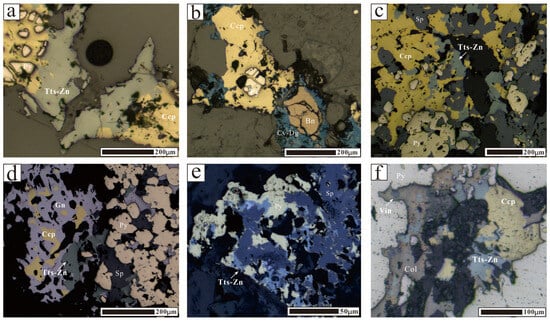
Figure 3.
Reflected light images of fahlores and associated minerals in the Zijinshan Xi’nan deposit. (a–c) Zn-rich tennantite and pyrite and chalcopyrite in the shallow part of the Zijinshan Xi’nan deposit (ZK327-3, z = 354 m; ZK327-14, z = 65.3 m); (d) Zn-rich tennantite in the central part of the Zijinshan Xi’nan deposit (ZK729-14, z = 237.38 m); (e) Zn-rich tennantite associated with sphalerite, chalcopyrite and galena in ZK1703 (ZK1703-16, z = 182.69 m); (f) Zn-rich tennantite and Sn-bearing minerals in the deep part of the Zijinshan Xi’nan deposit (ZK1127-32, z = −20.6 m). Abbreviations: Py—pyrite; Ccp—chalcopyrite; Cv—covellite; Dg—digenite; Col—colusite; Wol—wolframite; Vin—vinciennite; Sp—sphalerite; Gn—galena; Tts—tetrahedrite-tennantite solid solution.
In the Zijinshan Xi’nan deposit, the grain size of the fahlores gradually increases from deep to shallow levels, and zoning is commonly observed in BSE images. In the shallowest part, fahlores grow along the edges of chalcopyrite (Figure 3a), replacing chalcopyrite in anhedral forms. These grains are larger than 200 mm and appear light grayish-green under a microscope. BSE images reveal distinct oscillatory zoning, with zones larger than 20 mm showing regular variations. The core is enriched in Sb, while the outer zones alternate between As-rich and Sb-rich, with the As content steadily increasing outward. At deeper levels, the BSE images show tetrahedrite with oscillatory zoning surrounding an earlier, relatively homogeneous core. The oscillatory zones are less than 10 mm wide, while the core zones are larger than 100 mm. The core is enriched in Sb, and the outer zones are enriched in As (Figure 4a,b). In even deeper parts, fahlores replace chalcopyrite in anhedral forms and, together with sphalerite, envelop pyrite. These grains are smaller than 100 mm and appear light grayish-green under a microscope (Figure 4c,d). In most fahlores in the Zijinshan Xi’nan deposit, the zoning pattern is characterized by an Sb-rich core, gradually transitioning to As-rich edges (Table 2).
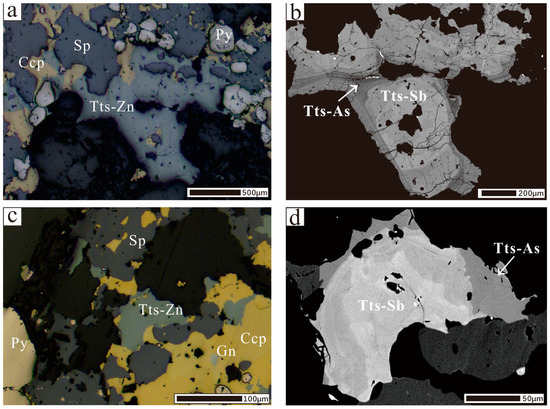
Figure 4.
Reflected light images and BSE images of the zoning of fahlores in the Xi’nan deposit. (a) Zn-rich tetrahedrite replacing sphalerite and chalcopyrite (ZK1127-14, z = 241.5 m); (b) oscillatory zoning of Zn-rich tetrahedrite in BSE image of Figure (a); (c) Zn-rich tennantite replacing chalcopyrite and sphalerite (ZK729-14, z = 237.38 m); (d) zoning of tennantite in BSE image of Figure (c). Abbreviations: Py—pyrite; Ccp—chalcopyrite; Sp—sphalerite; Gn—galena; Tts—tetrahedrite-tennantite solid solution.

Table 2.
EPMA analysis results of fahlores in the Zijinshan Xi’nan deposit (wt%).
5.3. Longjiangting Cu Deposit
In the Longjiangting deposit, fahlores are primarily distributed in the sericite alteration zone, diaspore-pyrophyllite alteration zone, and dickite-kaolinite alteration zone. They are absent in the propylitic alteration zone and chlorite alteration zone.
The shallow open-pit kaolinite belt of the Longjiangting deposit is characterized by the presence of a combination of covellite, Zn-rich arsenopyrite, Zn-rich tetrahedrite, and chalcopyrite (Figure 5a). The mineral composition of the fahlores is characterized by rich Sb (up to 25.26 wt%) and Zn (up to 8.28 wt%), with a small amount of samples being rich in Ag (up to 7.87 wt%); in the intermediate zone of the deposit, the copper mineral assemblage is characterized by Zn-rich tennantite + Zn-rich tetrahedrite + chalcopyrite + bornite + enargite + stannite + colusite and other Sn-bearing minerals (Figure 5b,c). The fahlores in this zone are notably enriched in Fe, with the content reaching up to 6.32 wt%. The minerals in the sericite alteration zone in the deep part of the deposit are characterized by other Bi-bearing minerals, such as chalcopyrite, wittchenite, aikinite, and emplectite (Figure 5e,f), and the composition of the fahlores is characterized as being Bi-rich (up to 15.24 wt%). Therefore, from shallow to deep, the Zn and Sb in the fahlores in the Longjiangting deposit gradually decreases, while Cu increases. The ore body shows a trend of Bi enrichment from shallow to deep (Table 3).
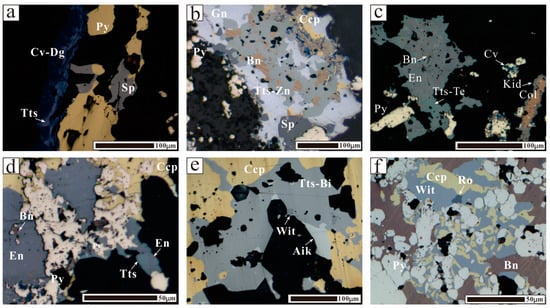
Figure 5.
Reflected light images of the mineral associations of fahlores in Longjiangting deposit. (a) fahlores intergrowth with covellite and digenite (ZK1202-5, z = 223.62 m); (b) fahlores associated with bornite and chalcopyrite replaced by covellite-digenite (DZK1A-9-2, z = 224.9 m); (c) replacement of enargite by Te-rich tennantite and replacement of bornite by covellite (DZK1A-9-12, z = 115.99 m); (d) replacement of enargite by Zn-rich tennantite (DZK1A-9-12, z = 115.99 m); (e) replacement of chalcopyrite by fahlores and aikinite (ZK401-32, z = 51.23 m); (f) coexisting of roquesite with wittchenite and chalcopyrite (ZK401-34, z = 43.23 m). Abbreviations: Py—pyrite; Ccp—chalcopyrite; Cv—covellite; Dg—digenite; En—enargite; Col—colusite; Sp—sphalerite; Gn—galena; Aik—aikinite; Kid—kiddcreekite; Wit—wittchenite; Ro-roquesite; Tts—tetrahedrite-tennantite solid solution.

Table 3.
EPMA analysis results of fahlores in the Longjinagting deposit (wt%).
The shallow part of the Longjiangting deposit consists of minerals from fahlores and covellite + digenite, which are associated with pyrite. There is also stromeyerite coexisting between the fahlores and chalcopyrite, with ring sizes ranging from 10 to 20 mm (Figure 6a,b); in the middle of the deposit, the fahlores and chalcopyrite appear in the form of solid solutions, enveloping residual pyrite and bornite together. The ring size is greater than 50 mm, and the core is rich in As and Fe, while the edges are rich in Bi and Zn (Figure 6c,d); the fahlores and chalcopyrite solid solution coexist with Bi minerals in the deep zones, such as wittchenite, aikinite, and emplectite. The core of tetrahedrite is rich in As, while the edges are rich in Sb and Ag (Figure 6e,f). Most of the minerals in the Longjiangting deposit of fahlores appear in solid solution form with chalcopyrite and often exhibit zoning under BSE. The zoning of the fahlores from deep to shallow has similar characteristics: an As-rich core with Sb-rich edges, and the grain of the fahlores gradually decrease from deep to shallow.
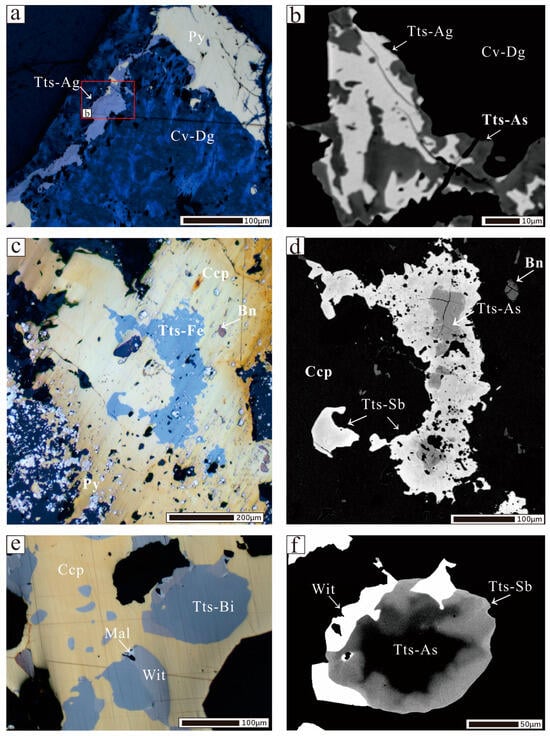
Figure 6.
Reflected light images and BSE images of the zoning of fahlores in the Longjiangting deposit. (a) Ag-tetrahedrite and covellite in the Longjiangting deposit (ZK1202-5, z = 223.62 m); (b) zoning of tetrahedrite replaced by covellite in BSE image of Figure (a); (c) solid solution of chalcopyrite and fahlores enclosing pyrite and bornite (DZK1A-9-7, z = 170.99 m); (d) zoning of fahlores in BSE image of Figure (c); (e) Bi-rich fahlore, coexisting with matildite and wittchenite, replacing chalcopyrite (DZK1A-9-18, z = 37.99 m); (f) BSE image showing zoning of fahlores with As-rich cores and Sb-rich rims. Abbreviations: Py—pyrite; Ccp—chalcopyrite; Cv—covellite; Dg—digenite; En—enargite; Mal—matildite; Sp—sphalerite; Gn—galena; Wit—wittchenite; Tts—tetrahedrite-tennantite solid solution.
5.4. Yueyang Ag-Polymetallic Deposit
In the Yueyang deposit, fahlores are primarily distributed in the sericite alteration zone, diaspore-pyrophyllite alteration zone, and dickite-kaolinite alteration zone. They are not observed in other alteration zones.
In the Yueyang deposit (ZK6112, ZK6511, ZK5906, and ZK6903), the overall mineral assemblage exhibits LS characteristics [1], including pyrite, chalcopyrite, galena, sphalerite, and argentite (Figure 7). The fahlores are enriched in Sb (up to 22.91 wt%), Zn (up to 10.30 wt%), and Ag (up to 9.59 wt%). In the deeper part of the deposit (DZK67-2), the copper mineral assemblage is characterized by chalcopyrite, aikinite, wittichenite, and emplectite, with fahlores enriched in Bi (up to 14.76 wt%) and Fe (up to 3.89 wt%). The Zn and Sb content in fahlores gradually decreases, while Cu content increases, accompanied by a trend of Bi enrichment. The fahlores in the Yueyang deposit show little variation with depth (Table 4).

Figure 7.
Mineral association of fahlores in Yueyang deposit under reflected light. (a) fahlores associated with sphalerite, pyrite and chalcopyrite in the upper part of Yueyang deposit (ZK5906-7, z = 47.48 m); (b) coexistence of galena, sphalerite, chalcopyrite, and argentite (ZK6903-6, z = 63.59 m); (c) fahlores replacing and enclosing pyrite, chalcopyrite, and galena (ZK1703-17, z = 181.19 m); (d) mineral association of fahlores, chalcopyrite, galena, and emplectite in the deep right part of the Yueyang deposit (DZK67-2-7, z = −82.34 m); (e,f) Fahlores, chalcopyrite, galena, colusite, wittchenite and vinciennite filling the fractures of pyrite (DZK67-2-8, z = −79.12 m). Abbreviations: Py—pyrite; Ccp—chalcopyrite; Col—colusite; Vin—vinciennite; Wit—wittchenite; Sp—sphalerite; Gn—galena; Tts—tetrahedrite-tennantite solid solution.

Table 4.
EPMA analysis results of fahlores in the Yueyang deposit (wt%).
The drill holes (ZK6112, ZK5906, ZK6903) of the Yueyang deposit are rich in As in the core and Sb in the edge, forming a self-shape and encapsulating galena with a particle size of less than 100 mm. They are located at the outermost edge of the Zijinshan porphyry mineralization system (Figure 8a,b). In the deep borehole (DZK67-2), the fahlores appear in solid solution form together with chalcopyrite to fill pyrite, with a ring size greater than 50 mm. The core is rich in As and Fe, and the edges are rich in Bi and Zn (Figure 8c,d); the fahlores appear together with Bi minerals, such as emplectite, aikinite, and wittchenite in the deep zones, presenting a different shape and being enveloped by chalcopyrite. They are rich in As and have Sb-rich edges. The Bi content at the edge is slightly higher than that in the middle. The oscillating fahlores are enveloped by other minerals, and this structural relationship indicates that they crystallized relatively slowly in the fluid that penetrated through small gaps and fractures between grains during early mineral aggregation (Figure 8f).
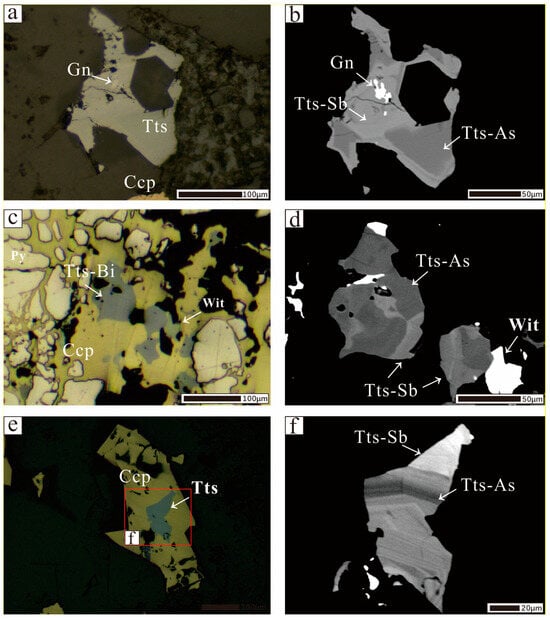
Figure 8.
Zoning of fahlores in the Yueyang deposit and their BSE images. (a) Self-growth zoning of fahlores (ZK6903-3, z = −0.59 m); (b) zoning of fahlores associated with Bi minerals in the BSE image of Figure (a); (c) replacement of chalcopyrite by tetrahedrite and emplectite (DZK67-2-8, z = −79.126 m); (d) zoning of fahlores in BSE image of Figure (c); (e) chalcopyrite enclosing Tts (DZK67-2-7, z = −82.341 m); (f) oscillatory zoning of tetrahedrite enclosed by chalcopyrite in Figure (e). Abbreviations: Py—pyrite; Ccp—chalcopyrite; Wit—wittchenite; Gn—galena; Tts—tetrahedrite-tennantite solid solution.
6. Discussion
6.1. The Mineral Composition and Substitution Mechanisms of Fahlores
The generalized formula for fahlores was first proposed in 1986 as (Cu,Ag)10(Cu,Fe,Zn)2(As,Bi,Sb,Te)4(S,Se)13 [46]. Based on the dominant elements, fahlores are classified as tennantite (As > Sb) and tetrahedrite (Sb > As). The molecular structure of fahlores allows for unlimited substitution of elements in the same position, such as the complete replacement of Sb by As or Bi in tetrahedrite [47]. The ratios of different elements in fahlores are used to study compositional zoning at the scale of ore bodies, deposits, and mining districts. These ratios can reflect the temperature, redox conditions, and the evolution of fluid-rock interactions during mineralization [17,19].
To validate and explore the relationships between elements in fahlores from the Zijinshan ore field, the EPMA data were processed and plotted for analysis (Figure 9). The (Sb+Bi+Te)/As plot shows a negative correlation, indicating that Sb, Te, Bi, and As in fahlores exhibit substitutional relationships. Similarly, the (Zn+Fe)/Cu-excess plot reveals a clear negative correlation between (Zn+Fe) and Cu-excess, indicating that Zn, Fe, and Cu-excess can substitute for each other within certain limits (Figure 10).
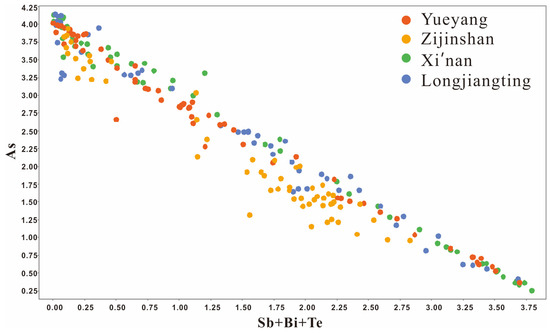
Figure 9.
Plot of As and (Sb+Bi+Te) atomic number relationship of the fahlores in the Zijinshan ore field.
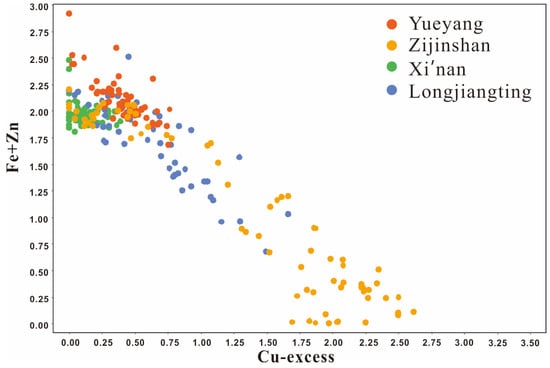
Figure 10.
Plot of the relationship between Cu-excess and (Fe+Zn) in fahlores from the Zijinshan ore field.
In fahlores, Sb, As, Bi, and Te exhibit mutual substitution, with a complete solid solution series existing between the Sb and As end-members (Figure 11). There is no significant correlation between Bi and the contents of Sb or As. Up to 3 to 3.5 Te atoms can substitute for Sb. Te and Sb are often incompatible in fahlores; when the content of Te or Sb exceeds 10 wt%, the content of Sb or Te is often below the detection limit of EPMA.

Figure 11.
The ternary diagram of As, Sb, and Bi in the fahlores in the Zijinshan ore field.
From the porphyry stage to the high sulfidation stage in the porphyry system, the sulfur fugacity and oxygen fugacity gradually increase [2]. The content of Cu and Fe in the fahlores is of great significance for the oxidation state of Fe, which helps us understand the conditions for mineral formation [17,18]. The spectroscopic study of Fe in the fahlores reveals that the increase in Cu content significantly corresponds to the transition of Fe from Fe2+ to Fe3+ in the minerals [19].
Fahlores containing more than 10 (Cu, Ag) atoms were first described by Charlat and Lévy and later referred to as Cu-excess tetrahedrite by Marcoux et al [48,49]. If the Cu content (apfu) exceeds 10, it substitutes for Fe in the ideal formula (Cu,Ag)10Fe2(As,Sb)4S13. If sufficient Fe is present as Fe2⁺, the Cu-excess is compensated by Fe3⁺, so when Cu-excess is greater than Fe3+, Fe2+ equals 0 (Figure 12), indicating that the fluid from which the tetrahedrite formed had high oxygen fugacity [50]. In tetrahedrite with maximum Fe content, all Fe is present as Fe3⁺, and the composition can be expressed as Cu11Fe3(As,Sb)4S13 [17]. The Cu-excess content can be used to infer the oxygen fugacity of the fluid, and the redox conditions can be directly determined using a Cu-Fe-Zn ternary diagram.
Based on the Cu-Fe-Zn ternary diagram for fahlores from the Zijinshan ore field (Figure 12), the Zijinshan Au-Cu deposit has the highest Cu-excess content, while the southwestern has the highest Zn content, followed by the Yueyang deposit. According to previous research [51], the presence of Zn in fahlores also indicates high oxygen fugacity. Combining the Zn and Cu-excess values of fahlores from the Zijinshan ore field, the inferred oxygen fugacity decreases in the following order: Zijinshan Au-Cu deposit > Zijinshan Xi’nan deposit > Longjiangting Cu deposit > Yueyang Ag-polymetallic deposit.
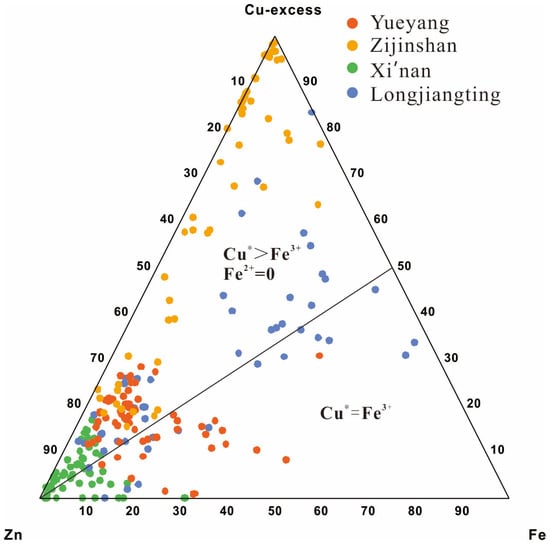
Figure 12.
The ternary diagram of Cu-excess, Fe, and Zn of the fahlores in the Zijinshan ore field. The base map is quoted from [52]. Cu* = Cu-excess.
In the Zijinshan Au-Cu deposit and the Longjiangting deposit, the Fe/(Fe+Zn) ratio varies widely, ranging from 0 to 1, while in the Zijinshan Xi’nan deposit and Yueyang deposit, the Fe/(Fe+Zn) ratio is mostly less than 0.5 (Figure 13). Fahlores with Cu (apfu) > 11 are characteristic of the transition from HS to IS stages [52]. Almost all the fahlores in the Zijinshan ore field exhibit Cu-excess, but only those in the Zijinshan Au-Cu deposit and Longjiangting deposit have Cu content exceeding 11 apfu, indicating that both deposits show features of a transition from HS to IS stages. This suggests a possible genetic link between the two deposits. Fahlores in the porphyry stage typically have Fe/(Fe+Zn) ratios greater than 0.4 [9], implying that the deep parts of the Zijinshan Au-Cu deposit and Longjiangting deposit may be close to concealed porphyry ore bodies.
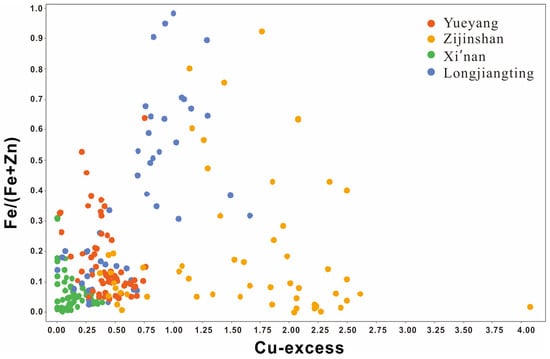
Figure 13.
Plot of the relationship between Cu-excess and Fe/(Fe+Zn) in fahlores from the Zijinshan ore field.
According to previous studies [9], Fe/(Fe+Zn) greater than 0.5 is a characteristic of porphyry, while less than 0.5 indicates a transitional stage. Therefore, most of the fahlores in the Zijinshan ore field exhibit transitional stage characteristics, while parts of Zijinshan and Longjiangting show porphyry stage characteristics (Figure 14).
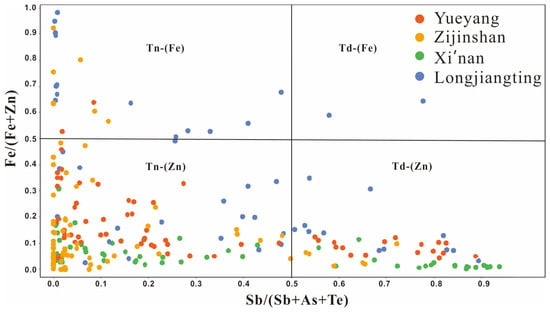
Figure 14.
Plot of the relationship between Sb/(Sb+As+Te) and Fe/(Fe+Zn) in fahlores from the Zijinshan ore field. Tn—tennantite; Td—tetrahedrite.
In various types of deposits, higher Fe and As contents indicate higher oxidation levels. In contrast, higher Sb and Zn contents favor the formation of tetrahedrite-(Ag) [12]. The mechanism of Ag incorporation in tetrahedrite is complex; it may occur through the substitution of monovalent Ag for monovalent Cu atoms or exist as a separate phase [53]. Previous research has shown that when the number of Sb atoms exceeds 0.5, the Ag content tends to be higher, and there is a positive correlation between Ag and Sb in fahlores. However, in the Zijinshan ore field, the fahlores generally have low Ag content, and the correlation between Ag and Sb is relatively weak (Figure 15). This weak positive correlation is controlled by crystallochemical factors [22]. Among the deposits, the correlation between Ag and Sb is most pronounced in the Zijinshan Xi’nan deposit, where the Fe content is also the lowest, consistent with previous research findings.
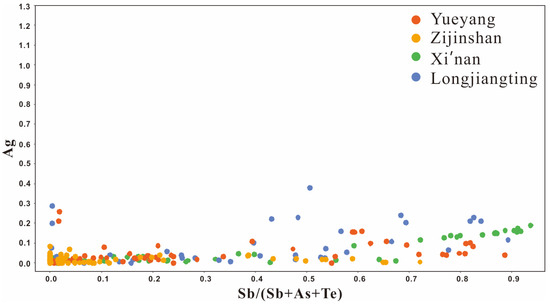
Figure 15.
Plot of the relationship between Ag and Sb/(Sb+As+Te) in fahlores from the Zijinshan ore field.
6.2. The Zoning and Genesis of Fahlores
Although minor in magmatic-hydrothermal deposits, fahlores are critical for deciphering ore-forming processes. They act as Ag/Au carriers and record physicochemical conditions (e.g., T, fO₂, fS₂, pH) during mineralization. Their trace element distribution and fluid migration patterns provide insights into deposit-scale metal transport and serve as exploration indicators [6,8,9,19,23,54].
Oscillatory zoning in fahlores reflects dynamic physicochemical shifts driven by fluid boiling/mixing. Near-local equilibrium conditions during crystal growth allow alternating As-Sb substitution, while cooling and evolving fluid chemistry control end-member solubility differences, generating compositional zonation [21,55].
The presence of zoning in fahlores indicates non-equilibrium growth conditions, where element diffusion is limited and crystal growth rates depend on boundary-layer fluid compositions [56,57]. BSE images reveal that most fahlores exhibit banding phenomena, primarily controlled by the temporal-spatial variability of ore-forming elements. These compositional bands form via internal self-organization mechanisms under disequilibrium, driven by concentration gradients at the mineral-fluid interface. Such gradients promote alternating enrichment of distinct elements (e.g., As vs. Sb), resulting in oscillatory zoning.
In the Zijinshan ore field, fahlores predominantly occur as fine-grained aggregates along sulfide fractures or as solid solutions infilling other sulfides. Microscopy, BSE imaging, and EPMA analyses classify them into two types: non-zoned and zoned varieties, with most exhibiting zoning (including distinctive oscillatory zoning) [8]. Oscillatory zoning—characterized by cyclic As-Sb-Fe-Zn variations in BSE images—is a key feature. Oscillatory-zoned tetrahedrite coexists with non-zoned types in the same sample but shows minimal compositional influence from external fluid changes (e.g., temperature, composition) at the millimeter scale [21]. In porphyry systems, such zoning solely arises from As-Sb substitution, consistent with Zijinshan’s patterns, where Fe/Zn remain stable across the zones (Figure 16), confirming its affinity to porphyry-type mineralization [10].

Figure 16.
Variations in the Sb, As, Fe, and Zn concentrations along the profile within zoned crystal of the fahlores. (a). The zoning fahlores under backscattering (ZK6112-22, z = 38.5 m); (b). The points in the figure correspond to the changes in element concentration at different points in Figure a; (c). The zoning of fahlores under backscattering (ZK327-3, z = 354 m); (d). The points in the figure correspond to the changes in element concentration at different points in Figure c.
In the Zijinshan Xi’nan deposit, shallow fahlores display a zoning progression: unzoned → irregularly zoned → oscillatory-zoned (encapsulating irregular zones) → As/Sb-alternating oscillatory zones (Figure 4 and Figure 16). This sequence implies oscillatory zoning formed during late-stage mineralization under stable physicochemical conditions.
EPMA mapping of Zijinshan fahlores reveals their structural and compositional architecture, enabling reconstruction of spatiotemporal fluid evolution and mineralization processes.
Fahlores exhibit distinct elemental correlations: As-Sb negative correlation and Te-As positive correlation, with oscillatory growth bands in the BSE images indicating crystal growth directions (Figure 17). Element substitution sequences reveal Sb/Zn enrichment, followed by As/Te, while Te/Bi preferentially replace As. In magmatic-hydrothermal systems, zoning patterns show Cu-As-rich cores and Sb-Ag-rich peripheries [8]. EPMA mapping delineates element distributions and inter-mineral relationships, enabling reconstruction of replacement processes, element precipitation sequences, and fluid compositional evolution during mineralization.

Figure 17.
EPMA mapping of Te, As, Sb, Bi, Zn in oscillatory zoning of tetrahedrite.
The solid solution of tennantite-enargite is difficult to identify under a microscope. Through EPMA data, it is observed that Zn and Bi are enriched in tennantite, while Zn- and Bi-poor areas correspond to enargite. The EPMA mapping results align with mineralogical observations, clearly illustrating the relationships between tennantite, enargite, chalcopyrite, and stannite: chalcopyrite precipitates first, filling fractures in pyrite, followed by the sequential precipitation of enargite and tennantite, which are later replaced by stannite (Figure 18). Sn-rich minerals precipitate at the Sb-rich edges of tetrahedrite. The EPMA mapping, by visually displaying the spatial distribution and replacement sequence of minerals such as tennantite, enargite, chalcopyrite, and stannite, combined with the characteristics of elemental distribution, reveals the compositional evolution of the ore-forming fluids, providing evidence for reconstructing the ore-forming processes.
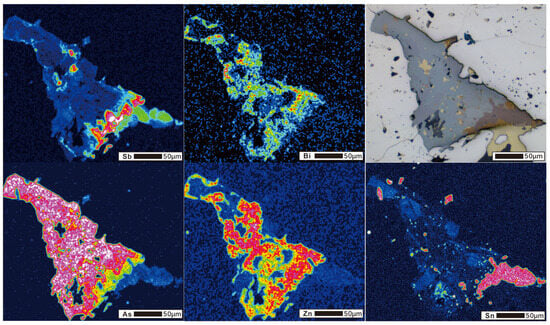
Figure 18.
EPMA mapping of the solid solution series between fahlores and enargite.
Te-rich tetrahedrite is typically associated with intermediate- to low-temperature hydrothermal systems and exhibits a close genetic link to Cu-Au-Ag mineralization. As a critical indicator of Te enrichment in ore-forming fluids [54], its compositional zoning revealed by EPMA mapping demonstrates spatial correlation with Au-Ag mineralization. In the Zijinshan Au-Cu deposit, Te-rich tetrahedrite encapsulates Au-Ag minerals along its growth bands (Figure 19). EPMA element distribution maps (Te, As, Sb, Bi, Cu, Fe) elucidate the compositional evolution of hydrothermal fluids, metal enrichment mechanisms, and fluid migration pathways, providing key constraints for reconstructing ore-forming processes and exploration targeting. Te-rich tetrahedrite has been identified in both the central Longjiangting deposit and the Zijinshan Au-Cu deposit within the Zijinshan ore field. Spatial distribution patterns suggest a potential concealed hydrothermal center at depth under the two deposits.

Figure 19.
EPMA mapping of Te, As, Sb, Bi, Ag, and Fe in oscillatory zoning of Te-rich tetrahedrite.
6.3. Spatial Evolution and Prospecting Indicators of the Fahlores
The fahlores in the Zijinshan ore field exhibit spatially zoned evolution, reflecting systematic variations in ore-forming environments and fluid evolution. Their distribution patterns, compositional trends, and mineral associations provide critical vectors for regional exploration targeting.
The shallow zones (open-pit to upper drill cores) of the Zijinshan Au-Cu deposit host a Cu assemblage dominated by chalcopyrite + bornite + covellite + digenite + enargite + wittichenite + goldfieldite, indicative of high sulfur fugacity and oxidizing fluids. The presence of goldfieldite highlights Te-As-rich fluid inputs. Deeper drill core sections reveal a distinct assemblage: Zn-rich tennantite + stannite + colusite + chalcopyrite + bornite + covellite + digenite. This marks a fluid evolution from HS to IS conditions. Zn-rich tennantite signals Zn-As enrichment, while stannite and colusite reflect Sn-V-Ge incorporation, indicating contributions from deeper porphyry-related hydrothermal systems.
In the Zijinshan Xi’nan deposit and drill hole ZK1703, the evolution of major copper minerals is as follows: in the late shallow part, the assemblage is pyrite + chalcopyrite + covellite + digenite; in the middle part, it transitions to pyrite + chalcopyrite + bornite; and in the early deep part, it consists of pyrite + chalcopyrite + magnetite + hematite. From deep to shallow levels, the mineral assemblages indicate a gradual increase in sulfur fugacity, with corresponding changes in the fahlores: early deep parts feature Fe-tennantite, while late shallow parts are characterized by Ag-tennantite. From deep to shallow levels in the Zijinshan Xi’nan deposit, the Cu in the fahlores gradually increases, while Fe decreases. The ore bodies show a trend of increasing Sb and Ag from deep to shallow levels (Figure 20). The profile diagram reveals that the elemental composition of fahlores transitions from Bi-rich in the deep parts to Zn-rich and then to Fe- and Ag-rich in the shallow parts.

Figure 20.
Profiles of drill holes and fahlores with different characteristics in the Zijinshan deposit and the Zijinshan Xi’nan deposit (A-A’ in Figure 1).
The Longjiangting deposit is a hydrothermal system characterized by deep porphyry mineralization overlaid by shallow HS epithermal mineralization [23,42]. In the shallow part of the deposit (Figure 21), the copper mineral assemblage is dominated by pyrite + covellite-digenite ± chalcopyrite. In the middle part of the ore body, a copper mineral assemblage similar to that of the Zijinshan Xi’nan deposit and the deep part of the Zijinshan Au-Cu deposit is observed, consisting of Zn-rich tennantite + Zn-rich tetrahedrite + chalcopyrite + bornite + enargite. In the deep part of the ore body, the mineral assemblage is characterized by pyrite + chalcopyrite, with sulfosalt minerals, such as Fe-tennantite + aikinite + wittichenite + emplectite, consistent with the features observed in the deep drill holes on the right side of the Yueyang deposit.
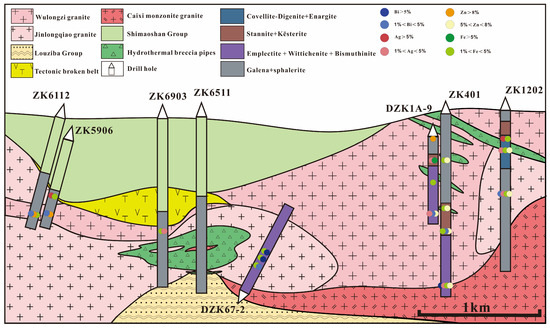
Figure 21.
Profiles of drill holes and fahlores with different characteristics in Longjiangting deposit and Yueyang deposit (B-B’ in Figure 1).
The Yueyang deposit is primarily characterized by a copper mineral assemblage of pyrite + chalcopyrite + Zn-rich tennantite, which may imply an LS environment. In the deeper sections on the right side, there are indications of IS, with mineral assemblages including aikinite + wittichenite + emplectite. The fahlores in this zone are enriched in Bi, similar to the mineral assemblages and corresponding fahlores found in the middle sections of the Longjiangting drill holes. These mineral assemblages indicate that the sulfur fugacity of the deposit gradually increases from deep to shallow levels. In the deep parts of the Longjiangting and Yueyang deposits, the fahlores are enriched in Bi and Fe, while the shallow parts of the Longjiangting deposit are enriched in Sb, Zn, and Ag.
The Zijinshan Au-Cu deposit displays a vertically zoned magmatic-hydrothermal system, transitioning from shallow high-sulfur (HS) to deep porphyry-related environments. In the shallow HS zone, Sb-Te-enriched fahlores coexist with covellite-digenite, exhibiting oscillatory zoning indicative of fluid compositional fluctuations and rising oxygen fugacity. The intermediate transition zone (Zijinshan Xi’nan and Longjiangting deposits) features Zn-Fe-rich fahlores associated with chalcopyrite-bornite, marking a compositional shift from Sb- to As-dominance that reflects HS → IS fluid evolution. Deeper porphyry peripheries host As-Bi-rich fahlores with chalcopyrite-emplectite, signaling reduced conditions and linkages to concealed porphyry roots. Regionally, deep F-Mn-Pb-Zn geochemical anomalies align with porphyry copper signatures [37,58,59], while shallow HS overprinting (digenite-enargite-bornite) and transitional IS → LS assemblages (Yueyang Ag-polymetallic deposit) underscore a unified hydrothermal continuum [2]. These zonations—Bi-As anomalies in deep porphyry zones and Sb-Zn-Ag enrichment in epithermal pathways—provide critical vectors for targeting concealed mineralization, confirming the Zijinshan ore field as an integrated magmatic-hydrothermal system with exploration significance for buried porphyry-epithermal transitions [23,42].
The compositional evolution of fahlores in the Zijinshan Au-Cu deposit reflects a systematic transition from HS to porphyry systems. In shallow HS zones, Sb-Te-rich fahlores with oscillatory zoning (indicative of rapid fluid fluctuations and high oxygen fugacity) serve as key markers for epithermal Au-Cu mineralization, often coexisting with covellite-digenite. Transitional zones (e.g., Zijinshan Xi’nan and Longjiangting deposits) are marked by Zn-Fe-rich fahlores associated with chalcopyrite-bornite, signaling HS → IS fluid evolution and Sb-to-As compositional transitions. Deeper porphyry peripheries host As-Bi-rich fahlores linked to emplectite and reduced conditions, identifying concealed porphyry roots. Regional trends show a metal zoning sequence: Te-rich → Zn-rich → Bi-rich → Fe-rich in HS-to-porphyry transitions, and Bi-Fe-rich → Sb-Zn-Ag-rich in IS → LS transitions. These zonings—Sb-Te anomalies for shallow epithermal targets, Zn-Fe assemblages for transitional systems, and As-Bi signatures for deep porphyry exploration—provide critical vectors for multi-stage mineralization targeting, underpinning Zijinshan’s role as an integrated magmatic-hydrothermal hub.
Fluid inclusion research shows that the homogenization temperatures of the deepest alteration zones in the Zijinshan Au-Cu deposit are similar to those in the deep parts of the Zijinshan Xi’nan deposit and the middle parts of the Longjiangting deposit [26,34,40,42,60,61,62,63,64]. The distribution of several copper mineral assemblages in the Zijinshan ore field forms a continuous transition from the shallow parts of the Zijinshan Au-Cu deposit to the deep parts of the Longjiangting deposit. The spatial distribution characteristics suggest significant potential for porphyry deposits in the deep parts of the Zijinshan Au-Cu and Longjiangting deposits, indicating the possibility of discovering porphyry mineralization at depth.
7. Conclusions
The wide distribution of fahlores in the Zijinshan ore field may reflect the transitional zone environment overlying the porphyry ore bodies. The results indicate that in the Zijinshan Au-Cu deposit fahlores are Te-rich in shallow zones and Zn-rich in deep zones. The Zijinshan Xi’nan deposit is generally Zn-rich, with a Bi-rich central region. The Longjiangting deposit has Sb- and Zn-rich shallow zones and As- and Bi-rich deep zones, while the Yueyang deposit features Sb- and Zn-rich shallow zones and Bi-rich deep zones. The oscillatory zoning observed in the fahlores in the Zijinshan ore field is primarily caused by variations in As and Sb content, which is a typical characteristic of porphyry deposits.
The compositional evolution of fahlores is considered a criterion to separate porphyry, transitional, and epithermal HS, IS, and LS stages. During the evolution from the porphyry copper system to the HS Au-Cu hydrothermal system in the Zijinshan ore field, the compositional characteristics of fahlores exhibit a trend from Fe-rich → Bi-rich → Zn and Sb-rich → Te-rich. In the transition from the IS to the LS epithermal system, the composition of fahlores transitions from Bi-rich → Zn-rich → Ag-rich. This evolutionary sequence can be used to locate the hidden hydrothermal centers. The fahlores adjacent to the porphyry mineralization are enriched in Fe, Bi, and Zn, and have high oxygen fugacity, which may provide a basis for target area optimization.
The mineral compositions of fahlores and mineral assemblage zoning in the Zijinshan ore field reveal a unified porphyry-hydrothermal mineralization system, which suggests the possibility of multiple hidden hydrothermal centers in this ore field. By integrating the mineral assemblage, alteration zoning, mineral compositions of fahlores, and geochemical anomalies of the deposit, we suggest that there is great potential for exploration of porphyry mineralization in the deep parts of the Zijinshan Xi’nan Cu-Mo deposit and the Longjiangting Cu deposit.
Author Contributions
Conceptualization, methodology, software, formal analysis, and writing—original draft preparation, H.L.; validation, H.L.; data curation and investigation, H.L., J.C., J.Q., J.L. and H.C.; writing—review and editing, W.L., H.C., H.L. and J.C.; project administration, W.L.; resources and funding acquisition, X.L. All the authors have read and agreed to the published version of the manuscript.
Funding
This research was funded by the Comprehensive Study on Fine Mineralogy and Mineral Exploration Application of Zijinshan Ore field, grant number 01612216 and by Zijin Mining Group.
Data Availability Statement
Data are contained within the article.
Acknowledgments
I would like to express my heartfelt gratitude to my advisor, Liu, W.Y., for his patient guidance, to my labmates for their selfless assistance, and to my family and friends for their unwavering support and encouragement. It is your companionship and support that have enabled me to successfully complete this thesis.
Conflicts of Interest
Author Jianhuan Qiu and Xiaodan Lai were employed by the company Zijin Mining Group Co., Ltd. The remaining authors declare that the research was conducted in the absence of any commercial or financial relationships that could be construed as a potential conflict of interest.
References
- Sillitoe, R.H. Epithermal paleosurfaces. Miner. Depos. 2015, 50, 767–793. [Google Scholar]
- Sillitoe, R.H. Porphyry Copper Systems. Econ. Geol. 2010, 105, 3–41. [Google Scholar]
- Zhang, D.Q.; She, H.; Li, D.; Feng, C. The Porphyry-Epithermal Metallogenic System in the Zijinshan Area. Acta Geol. Sin. 2003, 77, 253–261. [Google Scholar]
- Zhang, J.Z. Geological Characteristics, Ore Deposit Models, and Exploration Practices in the Zijinshan Ore Concentration Area. Miner. Depos. 2013, 32, 758–767. [Google Scholar]
- Qiu, J.H.; Liu, W.Y.; Chen, J.W.; Lai, X.D.; Zhong, X.H.; Li, J.Y.; Long, H. Alteration mineralogy, characteristics and shortwave infrared spectroscopy of white mica in the Zijinshan ore field, Fujian Province: Implications for porphyry Cu prospecting. Ore Geol. Rev. 2024, 168, 106065. [Google Scholar]
- Plotinskaya, O.Y.; Grabezhev, A.I.; Seltmann, R. Fahlores compositional zoning in a porphyry-epithermal system: Biksizak occurrence, South Urals, Russia as an example. Geol. Ore Depos. 2015, 57, 42–63. [Google Scholar] [CrossRef]
- Dincă, G.; Popescu, G.C.; Topa, D. Decoding the mineralogy and geochemistry of sulfosalts in the Săcărâmb Au-Ag-Te ore deposit (Romania): Unveiling a fresh insight into the evolution of a complex hydrothermal system. Ore Geol. Rev. 2024, 176, 106424. [Google Scholar]
- Lyubimtseva, N.G.; Sack, R.O.; Bortnikov, N.S.; Borisovsky, S.E.; Balashov, F.V. The Zonal Fahlore from the Darasun Gold Deposit, Transbaikalia, Russia: An Example of a Self-organizing System and their Depositional Conditions. Geol. Ore Depos. 2023, 65, 346–380. [Google Scholar] [CrossRef]
- Marushchenko, L.I.; Baksheev, I.A.; Nagornaya, E.V.; Chitalin, A.F.; Nikolaev, Y.N.; Vlasov, E.A. Compositional evolution of the tetrahedrite solid solution in porphyry-epithermal system: A case study of the Baimka Cu-Mo-Au trend, Chukchi Peninsula, Russia. Ore Geol. Rev. 2018, 103, 21–37. [Google Scholar] [CrossRef]
- Wei, D.; Xia, Y.; Steadman, J.A.; Xie, Z.; Liu, X.; Tan, Q. Tennantite–Tetrahedrite-Series Minerals and Related Pyrite in the Nibao Carlin-Type Gold Deposit, Guizhou, SW China. Minerals 2021, 11, 2. [Google Scholar]
- Sun, R.L. Mineralization Temperature Calculated from Tetrahedrite Thermodynamic: Implication for Vein-type gold Mineralization in the Yixingzhai Gold Deposit, Shanxi. South China Geol. 2023, 39, 581–587. [Google Scholar]
- Xu, S.H. Mineralogical Characteristics and Genetic Significance of Tetrahedrite Series Minerals in the Lanping Basin Silver-Copper-Cobalt-Nickel Polymetallic Deposits. J. Chengdu Univ. Technol. 2005, 32, 556–564. [Google Scholar]
- Wang, D.H.; Chen, Y.; Ye, Q.; Liu, Y. Characteristics of Tetrahedrite in the Ashele Copper Deposit, Xinjiang. Acta Petrol. Miner. 1998, 17, 74–80. [Google Scholar]
- Huang, D.H. Characteristics and Significance of Silver Sulfosalt Minerals of the Tetrahedrite Group in Silver Polymetallic Deposits. Acta Petrol. Miner. 2000, 19, 78–87. [Google Scholar]
- Apopei, A.I.; Damian, G.; Buzgar, N.; Buzatu, A.; Andráš, P.; Milovska, S. The determination of the Sb/As content in natural tetrahedrite–tennantite and bournonite–seligmannite solid solution series by Raman spectroscopy. Miner. Mag. 2017, 81, 1439–1456. [Google Scholar]
- George, L.L.; Cook, N.J.; Ciobanu, C.L. Minor and Trace Elements in Natural TetrahedriTe-rich tennantite: Effects on Element Partitioning among Base Metal Sulphides. Minerals 2017, 7, 17. [Google Scholar]
- Catchpole, H.; Kouzmanov, K.; Fontboté, L. Copper-excess stannoidite and tennantiTe-rich tetrahedrite as proxies for hydrothermal fluid evolution in a zoned Cordilleran base metal district, Morococha, central Peru. Can. Miner. 2012, 50, 719–743. [Google Scholar]
- Kouzmanov, K.; Ramboz, C.; Bailly, L.; Bogdanov, K. Genesis of high-sulfidation vinciennite-bearing Cu-As-Sn (<Au) assemblage from the Radka epithermal copper deposit, Bulgaria: Evidence from mineralogy and infrared microthermometry of enargite. Can. Miner. 2004, 42, 1501–1521. [Google Scholar]
- Makovicky, E.; Forcher, K.; Lottermoser, W.; Amthauer, G. The role of Fe2+ and Fe3+ in synthetic Fe-substituted tetrahedrite. Miner. Petrol. 1990, 43, 73–85. [Google Scholar]
- Sack, R.O. Fahlore thermochemistry: Gaps inside the (Cu,Ag)10(Fe,Zn)2(Sb,As)4S13 cube. Petrology 2017, 25, 498–515. [Google Scholar]
- Lyubimtseva, N.G.; Bortnikov, N.S.; Borisovskii, S.E. Oscillatory Zoning in Tennantite-(Fe) at the Darasun Gold Deposit (Eastern Transbaikal Region, Russia). Geol. Ore Depos. 2020, 62, 177–203. [Google Scholar]
- Sack, R.O.; Loucks, R.R. Thermodynamic properties of tetrahedriTe-rich tennantite: Constraints on the interdependence of the Ag⇌Cu, Fe⇌Zn, Cu⇌Fe, and As⇌Sb exchange reactions. Am. Miner. 1985, 70, 1270–1289. [Google Scholar]
- Liu, W.Y. Mineralogy of the Zijinshan Porphyry-Epithermal System, Fujian Province. Ph.D. Thesis, Chinese Academy of Geological Sciences, Beijing, China, 2015. [Google Scholar]
- Chen, D.F.; Na, J.G.; Xiong, Y.H.; Zhong, T.D.; Li, X.M. Study of Sulfosalts and Tungsten-Tin Sulfides in the Bitian Copper-Gold-Silver Deposit, Fujian Province. Acta Geol. Sin. 1998, 72, 249–259. [Google Scholar]
- Chen, J.; Cooke, D.R.; Piquer, J.; Selley, D.; Zhang, L.J.; White, N.C. Hydrothermal Alteration, Mineralization, and Structural Geology of the Zijinshan High-Sulfidation Au-Cu Deposit, Fujian Province, Southeast China. Econ. Geol. 2019, 114, 639–666. [Google Scholar]
- Zhong, J.; Chen, Y.J.; Pirajno, F.; Chen, J.; Li, J.; Qi, J.P. Geology, geochronology, fluid inclusion and H–O isotope geochemistry of the Luoboling Porphyry Cu–Mo deposit, Zijinshan Orefield, Fujian Province, China. Ore Geol. Rev. 2014, 57, 61–77. [Google Scholar]
- Mao, J.R.; Ye, H.; Li, Z.; Zhao, X.L.; Liu, K.; Li, J.Y. Research on Mesozoic Magmatic Activity in South China: Current Status and Prospects. Acta Geol. Sin. 2013, 87 (Supp. S1), 137–138. [Google Scholar]
- Zhang, D.Q.; Feng, C.Y.; Li, D.X.; She, H.Q.; Dong, Y.J. Evolution of Ore-forming Fluids in the Porphyry-Epithermal Metallogenic System of the Zijinshan Area. Acta Geosci. Sin. 2005, 26, 127–136. [Google Scholar]
- Zhang, J. Geological and Geochemical Characteristics of the Zijinshan Copper-Gold Deposit. Geol. Explor. 2001, 37, 17–22. [Google Scholar]
- Chi, Z.; Ni, P.; Pan, J.Y.; Li, S.N.; Wang, G.G.; Yang, Y.L.; Xue, K.; Liao, J.F. Petrogenesis and tectonic setting of the Cretaceous volcanic-intrusive complex in the Zijinshan ore district, Southeast China: Implications for different stages of mineralization. J. Asian Earth Sci. 2020, 192, 104265. [Google Scholar]
- Jiang, S.H.; Liang, Q.L.; Bagas, L.; Wang, S.H.; Nie, J.F.; Liu, F.Y. Geodynamic setting of the Zijinshan porphyry–epithermal Cu–Au–Mo–Ag ore system, SW Fujian Province, China: Constraints from the geochronology and geochemistry of the igneous rocks. Ore Geol. Rev. 2013, 53, 287–305. [Google Scholar]
- Xu, C.; Chen, H.Y.; Huang, W.T.; Qi, J.; Duan, G.; Zhang, L.J.; Wu, C.; Zhang, S.; Zhong, W.B. Mesozoic multiphase magmatism at the Xi’nan Cu–Mo ore deposit (Zijinshan Orefield): Geodynamic setting and metallogenic implications. Ore Geol. Rev. 2017, 88, 768–790. [Google Scholar] [CrossRef]
- Huang, W.T.; Liang, H.Y.; Wu, L.; Wu, J.; Li, J.; Bao, Z.W. Asynchronous formation of the adjacent epithermal Au-Cu and porphyry Cu-Mo deposits in the Zijinshan orefield, southeast China. Ore Geol. Rev. 2018, 102, 351–367. [Google Scholar] [CrossRef]
- So, C.S.; Zhang, D.; Yun, S.T.; Li, D. Alteration-mineralization zoning and fluid inclusions of the high sulfidation epithermal Cu-Au mineralization at Zijinshan, Fujian Province, China. Econ. Geol. 1998, 93, 961–980. [Google Scholar] [CrossRef]
- Cui, X.; Liu, W.Y.; Liu, Y.; Li, X.M. Advances in the Geological Study of the Zijinshan High-Sulfidation Epithermal Gold-Copper Deposit. Acta Miner. Sin. 2015, 35, 167–177. [Google Scholar]
- Zhang, D.Q.; Li, D.X.; Zhao, Y.M.; Chen, J.H.; Li, Z.L.; Zhang, K.L. The Zijinshan Deposit in Fujian: The First Quartz-Alunite Type Epithermal Copper-Gold Deposit in Mainland China. Geol. Rev. 1991, 37, 481–491. [Google Scholar]
- Liu, W.; Cook, N.J.; Ciobanu, C.L.; Liu, Y.; Qiu, X.; Chen, Y. Mineralogy of tin-sulfides in the Zijinshan porphyry–epithermal system, Fujian Province, China. Ore Geol. Rev. 2016, 72, 682–698. [Google Scholar] [CrossRef]
- Pan, J.Y. Metallogenic Process and Genesis of the Zijinshan High-Sulfidation Epithermal Cu-Au Deposit, Fujian. Ph.D. Thesis, Nanjing University, Nanjing, China, 2019. [Google Scholar]
- Pan, J.Y.; Ni, P.; Chi, Z.; Yang, Y.L.; Li, S.N.; Bao, T.; Wang, W.B.; Zeng, W.C.; Xue, K. Spatial distribution and variation of ore body, alteration and ore-forming fluid of the giant Zijinshan epithermal Cu-Au deposit, SE China: Implication for mineral exploration. Geochem. Explor. Environ. Anal. 2018, 18, 279–293. [Google Scholar] [CrossRef]
- Zhao, X.Y.; Zhong, H.; Mao, W.; Bai, Z.J.; Xue, K. Molybdenite Re-Os dating and LA-ICP-MS trace element study of sulfide minerals from the Zijinshan high-sulfidation epithermal Cu-Au deposit, Fujian Province, China. Ore Geol. Rev. 2020, 118, 103363. [Google Scholar] [CrossRef]
- Xu, C.; Chen, H.Y.; White, N.; Qi, J.P.; Zhang, L.L.; Zhang, S. Study on the alteration and mineralization characteristics of the southwest copper molybdenum ore block in the Zijinshan ore field, Fujian, and the application of SWIR exploration. Geol. Miner. Depos. 2017, 36, 1013–1038. [Google Scholar]
- Chen, J.; Chen, Y.J.; Zhong, J.; Sun, Y.; Qi, J.P.; Li, J. Geological and ore-fluid characteristics of Longjiangting Cu deposit in Zijinshan Orefield, Fujian Province, and their genetic implications. Miner. Depos. 2015, 34, 98–118. [Google Scholar]
- Que, X.Q. Geological characteristics and geochemical/geophysical anomalies as prospecting indicators of the Longjiangting copper deposit in western Fujian. Miner. Resour. Geol. 2024, 38, 311–320. [Google Scholar]
- Ruan, S.K.; Huang, Y.J. Geological characteristics and prospecting directions of the Longjiangting copper deposit in Wuping, Fujian Province. Nonferrous Met. 2018, 70, 31–36. [Google Scholar]
- Liu, L.H.; Chen, J.; Zhou, T.F.; Sun, Y.; White, N.C. Silver occurrence state and deportment mechanism of Yueyang Ag polymetallic deposit in Zijinshan ore field, Fujian Province, China. Acta Petrol. Sin. 2024, 40, 987–1002. [Google Scholar]
- Cummings, M.L.; Johnson, M.L. Mineralogy and geochemistry of hydrothermal alteration at Glass Buttes, south-central Oregon. J. Geochem. Explor. 1986, 25, 233–234. [Google Scholar]
- Xu, G.F. Identification of Tetrahedrite Group Minerals and Their Practical Significance. Geol. Geochem. 1978, 6, 29–36. [Google Scholar]
- Charlat, M.; Lévy, C. Substitutions multiples dans la série tennantite˗tétraédrite. Bull. Minéralogie 1974, 97, 241–250. [Google Scholar]
- Breskovska, V.; Tarkian, M. Compositional variation in Bi-bearing fahlores. Neues Jahrb. Für Mineral. Monatshefte 1994, 1994, 230–240. [Google Scholar] [CrossRef]
- Vassileva, R.D.; Atanassova, R.; Kouzmanov, K. TennantiTe-rich tetrahedrite series from the Madan Pb-Zn deposits, Central Rhodopes, Bulgaria. Miner. Petrol. 2014, 108, 515–531. [Google Scholar]
- Makovicky, E.; Karanovic, L.; Poleti, D.; Balic-Zunic, T.; Paar, W.H. Crystal structure of copper-rich unsubstituted tennantite, Cu12.5As4S13. Can. Miner. 2005, 43, 679–688. [Google Scholar]
- Repstock, A.; Voudouris, P.; Zeug, M.; Melfos, V.; Zhai, M.G.; Li, H.Z.; Kartal, T.; Matuszczak, J. Chemical composition and varieties of fahlore-group minerals from Oligocene mineralization in the Rhodope area, Southern Bulgaria and Northern Greece. Miner. Pet. 2016, 110, 103–123. [Google Scholar] [CrossRef]
- Šoster, A.; Zaccarini, F.; Zavašnik, J. Tetrahedrite-(Hg) from the Litija deposit, Central Slovenia: Mineral chemistry insights into fluid evolution processes. Ore Geol. Rev. 2024, 173, 106272. [Google Scholar]
- Yakich, T.Y.; Voudouris, P.; Levochskaia, D.V.; Mazurov, A.K.; Shaldybin, M.V.; Lopushnyak, Y.M.; Ruban, A.S.; Dasi, E.; Maximov, P.N.; Sinkina, E.A. Sulfosalts and sulfates in the epithermal Au-Ag-Te Emmy deposit (Khabarovsk Territory, Far East of Russia): Implications for the mineralization process. Geosciences 2025, 15, 26. [Google Scholar] [CrossRef]
- Holten, T.; Jamtveit, B.; Meakin, P.; Cortini, M.; Blundy, J.; Austrheim, H. Statistical characteristics and origin of oscillatory zoning in crystals. Am. Miner. 1997, 82, 596–606. [Google Scholar]
- Haase, C.S.; Chadam, J.; Feinn, D.; Ortoleva, P. Oscillatory zoning in plagioclase feldspar. Science 1980, 209, 272–274. [Google Scholar] [PubMed]
- Wang, J.H.; Wu, J.P. Oscillatory zonation of minerals and self-organization in silicate solid-solution systems: A new nonlinear dynamic model. Eur. J. Miner. 1995, 7, 1089–1100. [Google Scholar]
- Li, W.Y.; Deng, C.; Gu, X.P.; Liu, Y.; Qiu, X.P.; Chen, Y.C. The crystal structure of kiddcreekite solved using micro X-ray diffraction and the EPCryst program. Miner. Mag. 2014, 78, 1517–1525. [Google Scholar]
- Liu, W.Y.; Chen, Y.C.; Liu, Y. EPMA and LA-ICP-MS micro-area element analysis of Cu-Fe-S minerals in the Zijinshan ore field and their geological significance. Earth Sci. Front. 2017, 24, 39–53. [Google Scholar]
- Zhao, H.X.; Li, B.; Zhou, Y.X.; Zhu, Z.Y.; Chen, S.M. Genesis of the giant Zijinshan epithermal Cu-Au deposit, Fujian Province, southeastern China: Cu-He-Ar isotope perspective. Ore Geol. Rev. 2022, 148, 105047. [Google Scholar]
- Zhao, X.Y. Study on Fluid Evolution and Element Enrichment Mechanisms of the Zijinshan Porphyry-Epithermal Mineralization System. Ph.D. Thesis, University of Chinese Academy of Sciences, Beijing, China, 2020. [Google Scholar]
- Zhong, J.; Chen, Y.J.; Chen, J.; Li, J.; Qi, J.P.; Dai, M.C. Study on fluid inclusions in the Luobuling porphyry copper molybdenum deposit in the Zijinshan ore field, Fujian Province. Acta Petrol Sin. 2011, 27, 1410–1424. [Google Scholar]
- Zhong, X.H.; Liu, Y.; Xu, T.; Liu, W.Y. Mineralogical characteristics of dickite in Zijinshan (ZJS) Au-Cu deposit. Acta Miner. Sin. 2017, 37, 7–15. [Google Scholar]
- Chen, J.; Chen, Y.J.; Zhong, J.; Sun, Y.; Li, J.; Qi, J.P. Research on fluid inclusions in Wuziqilong copper deposit in Zijinshan ore field, Fujian Province. Acta Pet. Sin. 2011, 27, 1425–1438. [Google Scholar]
Disclaimer/Publisher’s Note: The statements, opinions and data contained in all publications are solely those of the individual author(s) and contributor(s) and not of MDPI and/or the editor(s). MDPI and/or the editor(s) disclaim responsibility for any injury to people or property resulting from any ideas, methods, instructions or products referred to in the content. |
© 2025 by the authors. Licensee MDPI, Basel, Switzerland. This article is an open access article distributed under the terms and conditions of the Creative Commons Attribution (CC BY) license (https://creativecommons.org/licenses/by/4.0/).